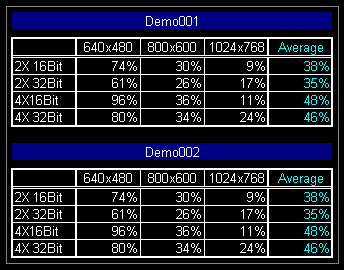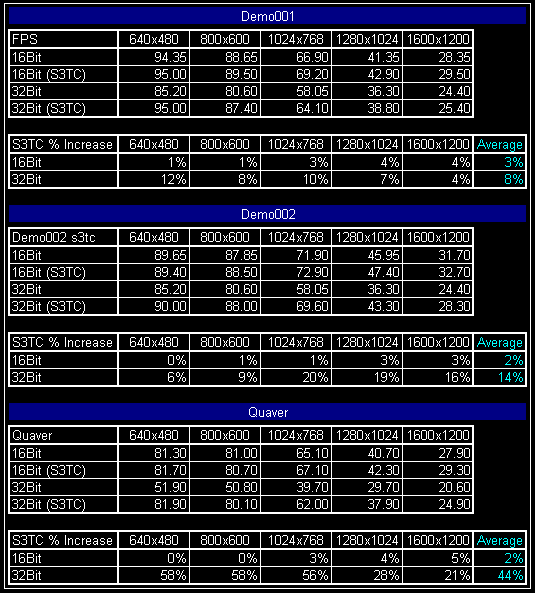FSAA Performance Analysis
As I did with my GTS review I'll use Quake 3 Demo001 and Demo002 for a bit of extra FSAA analysis.
The following table shows how the FSAA performance equates to is normal resolution. For instance in Demo001 at 1024x768x32 the Vivid! scores 52.9FPS normally and 16.4FPS with 4XFSAA; however in the FSAA settings it is internally drawing 4 times the number of pixels, and so the relative performance table takes that into account. To achieve the results I divided the normal resolution scores by the relative FSAA depth, and gave that as a percentage increase (or decrease) over the normal resolution - i.e. for the above scores: 52.9/4 = 13.23; (16.4-13.23)/13.23 = 0.2396 = 24% performance increase in comparison to the normal resolution.

As we can see, KYROs FSAA implementation is always giving us a performance increase in relation to the normal non-FSAA rending. This is most likely attributable to the fact that there are no extra bandwidth penalties associated with FSAA rendering in KYROs case. However we can't tell if this would still hold true in 1280x1024 and 1600x1200 resolutions as they are available.
I get the impression that if only KYRO had a little more fillrate these scores could be even more impressive.
S3TC Performance
Again, I'll use Quake 3 to give an indicator as to the performance game of using S3TC on the Vivid board.

See here for fillrate graphs
Both Demo001 and Demo002 show reasonably similar results from enabling ST3C. In 16Bit mode we gain a minimal performance advantage; from zero to 4% at the higher resolutions. 32Bit shows extra gain, going as high as 20%; this can be attributed to the alleviation in bandwidth requirements S3TC's 6:1 compression ratio gives.
I felt it was important to include the Quaver benchmark here as well; we've already established that due to Quaver's high texture demands in 32Bit mode it, it forces the card into texturing across the AGP bus as there is not enough local memory on the card to store the textures. Well, in this case not only does the 6:1 compression ratio of S3TC give us the bandwidth benefits, but it also means the difference between the textures fitting in the cards RAM and spilling over to the system RAM; with S3TC enabled the compression is such that all the textures can fit in the cards RAM and hence we gain a considerable level of performance.
